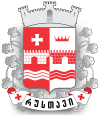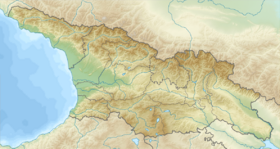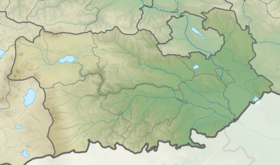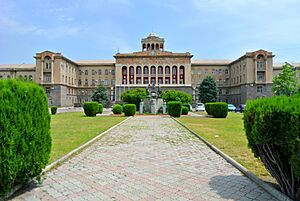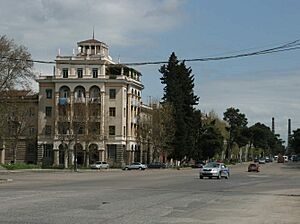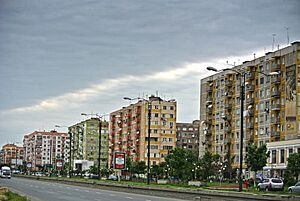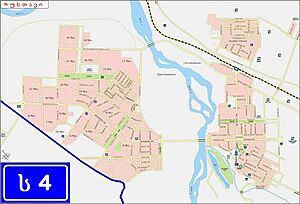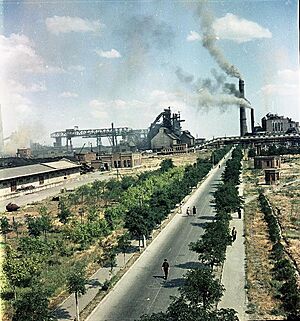Rustavi facts for kids
Quick facts for kids
Rustavi
რუსთავი
|
|||
|---|---|---|---|
|
City
|
|||
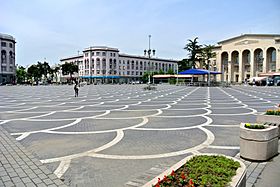
Rustavi Square
|
|||
|
|||
| Country | |||
| Mkhare | Kvemo Kartli | ||
| Municipality | Gardabani | ||
| Government | |||
| • Type | Mayor–Council | ||
| • Body | Rustavi City Assembly | ||
| Area | |||
| • Total | 60.6 km2 (23.4 sq mi) | ||
| Elevation | 330 m (1,080 ft) | ||
| Population
(2024)
|
|||
| • Total | 130,554 | ||
| • Density | 2,154.4/km2 (5,580/sq mi) | ||
| Population by ethnicity | |||
| • Georgians | 91.8 % | ||
| • Azerbaijanis | 3.7 % | ||
| • Armenians | 1.6 % | ||
| • Russians | 1.2 % | ||
| • Ossetians | 0.4 % | ||
| Time zone | UTC+4 (Georgian Time) | ||
| Postal code |
3700
|
||
| Area code(s) | (+995) 341 | ||
| Climate | Cfa | ||
Rustavi (Georgian: რუსთავი) is a city in the southeast of Georgia. It is located in the region of Kvemo Kartli, about 20 km (12 miles) southeast of the capital city, Tbilisi. As of January 2023, Rustavi has a population of 132,333 people. This makes it the fourth largest city in Georgia. The city's economy is mostly focused on the Rustavi Metallurgical Plant.
Contents
A Brief History of Rustavi
Rustavi is one of Georgia's oldest cities. Its history can be divided into two main parts. The first part covers ancient times until the city was destroyed in the 13th century. The second part is its modern history, starting from the Soviet era and continuing to today.
How Old is Rustavi?
An 11th-century Georgian writer, Leonti Mroveli, wrote about the city's beginnings. In his book "Georgian Chronicles", he said that Kartlos, the ancestor the Georgians are named after, founded the city. Kartlos's wife also started a town along the Kura river called Bostan-Kalaki, which means "city of gardens."
The same writer mentioned Rustavi as one of the castles that fought against Alexander the Great's army. However, it is known that Alexander never actually invaded this part of Georgia. Rustavi is mentioned alongside other ancient towns like Uplistsikhe and Mtskheta. This suggests that Rustavi might have been founded as early as the 5th or 4th centuries B.C.
Archaeological digs at the Rustavi castle also show that it was an important political and administrative center in ancient Iberia (the old name for Georgia). In the late 4th century A.D., Trdat of Iberia built a church and a canal in Rustavi.
Rustavi in Medieval Times
During the rule of Vakhtang I of Iberia in the 5th century, Rustavi played a big role in the politics of the Kingdom of Iberia. In the early 6th century (503 A.D.), the Sassanids from Persia took over Iberia. They made it a Persian province ruled by a governor called a marzpan.
Later, Byzantine Emperor Heraclius's attacks in 627 and 628 defeated the Persians. This made the Byzantines more powerful in Georgia until the Arabs invaded. During the fight against Arab rule, Rustavi was part of the Principality of Kakheti. This area later became the Kingdom of Kakheti-Hereti. Its ruler, Kvirike III the Great, put a duke (called an Eristavi) in charge of Rustavi.
After the Arabs were defeated, Georgia was invaded by the Turk-Seljuks from Central Asia in 1068. Their leader was Sultan Alp Arslan. King Bagrat IV of Georgia fought a big battle against the Seljuks and was badly defeated. Because of this, the king of Kakheti became independent and worked closely with the Turk-Seljuks.
After these Seljuk invasions, allied forces took Tbilisi and Rustavi. They gave the cities to the ruler of Tbilisi. During this time, Rustavi became less important. Its economy was ruined, and it remained only a strong, fortified town because of its important location. In 1069, Bagrat IV defeated the ruler Fadlun and captured the fortresses of Rustavi, Partskhisi, and Agarani.
During the campaigns against the Seljuks led by David IV, Rustavi was very important for protecting Georgia's southern borders. Sadly, Rustavi was completely destroyed after Timur's invasion of Georgia.
Rustavi's Modern Comeback
Rustavi was rebuilt as a major industrial city during the Soviet era. This rebuilding was part of Joseph Stalin's plan to quickly industrialize the country. The city got ironworks, steelworks, chemical plants, and an important railway station on the Tbilisi–Baku railroad line. Rustavi became home to about 90 large and medium-sized factories.
The main industrial activity in Rustavi was the Rustavi Metallurgical Plant. It was built between 1941 and 1950 to process iron ore from nearby Azerbaijan. Stalin brought workers from different parts of Georgia, especially from the poorer rural areas of Western Georgia. Rustavi became a key industrial hub for the Transcaucasus region. Its factories started making steel products, cement, chemicals, and synthetic fibers.
May 1944 was a big moment for modern Rustavi. Geologists started checking the ground where the metallurgical plant would be built. The area was mostly empty, with only temporary homes. Many people came to Rustavi from all over Georgia. The first newspaper, "Metallurgiisatvis" (meaning "For Metallurgy"), was published on August 30, 1944.
Rustavi had many housewarming parties as more and more people moved there every day. In 1948, the first streets in Rustavi were named. One street was named after the Young Communist League, another after the city's builders, and a third after its ancient name, Bostan-Kalaki.
On January 19, 1948, a special order made Rustavi an important city for the Georgian Soviet Socialist Republic. On April 27, 1950, the whole city celebrated the production of the first industrial Georgian steel. The celebration honored the ancient Khalibs, who were believed to have first lived in the area.
German POWs (prisoners of war) captured in World War II helped build Rustavi. Today, Rustavi is split into two parts: Dzveli Rustavi (Old Rustavi) and Akhali Rustavi (New Rustavi). Old Rustavi has buildings in the old Soviet style, while New Rustavi has many Soviet-era apartment blocks.
When the Soviet Union fell in 1991, it was very hard for Rustavi. Many factories closed down, and 65% of the city's people lost their jobs. This led to social problems like high crime and poverty. The population dropped from 160,000 in the mid-1990s to 116,000 in 2002 as people moved away to find work.
Artist Greg Lindquist has shown Rustavi's old concrete factories in his paintings. He has also worked with Georgian artists like Gio Sumbadze on projects about these buildings.
Who Lives in Rustavi?
At the start of 2021, Rustavi had over 130,072 residents. This was a 4% increase since the 2014 census. This growth makes Rustavi the fourth most populated city in Georgia. Rustavi grew very quickly when factories were built under Stalin.
After Georgia became independent in 1991, many people left Rustavi because of job losses. The population was lowest around 2002. However, it started growing again in the 2010s as factories reopened and more jobs became available.
In 2014, almost 92% of Rustavi's population was Georgian. There were also smaller groups of Azerbaijanis (3.7%), Armenians (1.6%), and Russians (1.2%). More than 500 Ossetians (0.4%) also lived in the city. Other groups included Ukrainians, Yazidis, Greeks, and Assyrians.
The mix of people in Rustavi has changed over time. During the Soviet period, there were many more Russians. The city also had a larger Ossetian community. But after the Soviet Union fell and during civil conflicts, many people moved away. This made the city much more Georgian.
How Rustavi is Governed
Rustavi is a self-governing city. This means it has its own local government. The City Council is the group that represents the people, and the City Hall is the group that carries out the city's plans. Rustavi is divided into 10 administrative areas:
- David Agmashenebeli district
- Old Rustavi district
- Shota Rustaveli district
- Zhiuli Shartava district
- Giorgi Chkondideli district
- Ilia Chavchavadze district
- Vakhtang Gorgasali district
- Iakob Tsurtaveli district
- Nikoloz Baratashvili district
- district named after the 13 Assyrian fathers
The City Council
The Rustavi City Assembly (Georgian: რუსთავის საკრებულო, Rustavi Sakrebulo) is the group of people who represent the city. It has 35 members who are chosen every four years.
The last election for the City Assembly was in October 2021. Rustavi was one of only seven cities where the ruling Georgian Dream party did not win a majority of seats in the council.
The Mayor of Rustavi
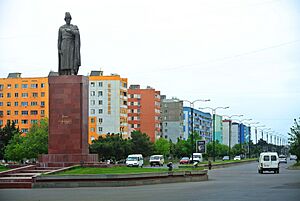
The most recent election for mayor was on October 2, 2021. There was a second round of voting on October 30. Nino Latsabidze from the Georgian Dream party won the election. She defeated Davit Kirkitadze from the United National Movement party.
Here are the results:
| Candidate | Party | First round | Second round | |||
|---|---|---|---|---|---|---|
| Votes | % | Votes | % | |||
| Nino Latsabidze | Georgian Dream | 22,352 | 44.84 | 27,298 | 53.71 | |
| David Kirkitadze | United National Movement | 21,706 | 43.54 | 23,523 | 46.29 | |
| Beqa Liluashvili | For Georgia | 3,401 | 6.82 | |||
| Tornike Arevadze | Alliance of Patriots | 1,231 | 2.47 | |||
| Vazha Bakhturidze | European Democrats | 751 | 1.51 | |||
| Elguja Kochiashvili | "Whites" | 408 | 0.82 | |||
| Total | 49,849 | 100.00 | 50,821 | 100.00 | ||
| Valid votes | 49,849 | 95.57 | 50,821 | 95.84 | ||
| Invalid/blank votes | 2,308 | 4.43 | 2,205 | 4.16 | ||
| Total votes | 52,157 | 100.00 | 53,026 | 100.00 | ||
| Registered voters/turnout | 106,895 | 48.79 | 106,869 | 49.62 | ||
| Source: CEC, CEC | ||||||
Past Mayors of Rustavi
- Irakli Tabagua (GD) (2017–2021)
- Davit Jikia (GD) (2014–2017)
What is Rustavi's Climate Like?
Rustavi has a Subhumid temperate climate (called Cwa by the Köppen climate classification). This means it has hot, wet summers and winters that are relatively cold and drier.
| Climate data for Rustavi | |||||||||||||
|---|---|---|---|---|---|---|---|---|---|---|---|---|---|
| Month | Jan | Feb | Mar | Apr | May | Jun | Jul | Aug | Sep | Oct | Nov | Dec | Year |
| Mean daily maximum °C (°F) | 6.3 (43.3) |
7.9 (46.2) |
12.4 (54.3) |
19.6 (67.3) |
24.8 (76.6) |
28.6 (83.5) |
31.9 (89.4) |
31.6 (88.9) |
27.0 (80.6) |
20.3 (68.5) |
13.4 (56.1) |
8.2 (46.8) |
19.3 (66.8) |
| Daily mean °C (°F) | 2.0 (35.6) |
3.4 (38.1) |
7.3 (45.1) |
13.6 (56.5) |
18.6 (65.5) |
22.5 (72.5) |
25.8 (78.4) |
25.4 (77.7) |
21.1 (70.0) |
14.8 (58.6) |
8.8 (47.8) |
4.0 (39.2) |
13.9 (57.1) |
| Mean daily minimum °C (°F) | −2.3 (27.9) |
−1.1 (30.0) |
2.2 (36.0) |
7.6 (45.7) |
12.5 (54.5) |
16.4 (61.5) |
19.8 (67.6) |
19.3 (66.7) |
15.3 (59.5) |
9.4 (48.9) |
4.3 (39.7) |
−0.3 (31.5) |
8.6 (47.5) |
| Average precipitation mm (inches) | 21 (0.8) |
27 (1.1) |
32 (1.3) |
46 (1.8) |
75 (3.0) |
69 (2.7) |
41 (1.6) |
40 (1.6) |
37 (1.5) |
41 (1.6) |
34 (1.3) |
22 (0.9) |
485 (19.2) |
| Source: Climate-Data.org | |||||||||||||
Sports and Activities in Rustavi
Rustavi Race Circuit
The Rustavi International Motorpark is the last racetrack built in the former Soviet Union. Races started there in late 1979, and it hosted eleven USSR Championship events until 1989. By 2009, the track was in poor condition. That year, a private company bought it. After being completely rebuilt in 2011–2012, the track reopened. It now hosts many racing events, including the TCR International Series, Formula Alfa series, Legends championship, and BMW Annual Festival. It also holds drag and drift competitions, and amateur races.
Basketball
Rustavi is home to the basketball club BC Rustavi. This team plays in the Georgian Superliga, which is Georgia's top basketball league. They play their home games at the Rustavi sports arena.
Martial Arts
The Shavparosnebi (Blackshields) is a group in Rustavi that practices traditional Georgian sports and martial arts. They are very active and hold competitions.
Famous People from Rustavi
- Robert Tedeyev (born 1986), a former professional football player from Russia.
- Davit Zirakashvili (born 1983), a former Georgian rugby union player.
Sister Cities of Rustavi
Rustavi has "sister city" relationships with many cities around the world. These partnerships help build cultural and economic ties.
See also
 In Spanish: Rustavi para niños
In Spanish: Rustavi para niños



